Food is a pretty universal thing. Meals tie families together, dishes create cultural and social distinctions, and one should not forget that eating just so happens to sustain our lives. Where we eat our food also says a lot about what's going on in our lives. Are we on the run, enjoying a social time with friends and family or simply stuffing our faces with snacks while watching the world cup? This page aims to look at food from the Malawian perspective, including recipes, stories, and photos of what I've been eating (setting included).
Below also find a list of recipes of Malawian food I’ve compiled by watching my family cook, as well as attempting to help cook the food myself (often to their frustration). All the recipes below I observed being cooked over an open fire and of course without the luxury of measuring cups, but the amazing intuition of my host mother and aunts, who have an amazing sense of the right proportions for each dish. I hope you enjoy Malawian fare in your kitchen, and pray you don’t experience and international incident.
A note about ingredients: Even throughout rural Malawi grocery stores are common place, and fairly large “Cash and Carry”s exist in the cities. Despite this most ingredients for the dishes described below are from open air markets where rock salt is sold by the cupful, sugar by the bagful and fruits and vegetables by the tomato, onion, orange, banana or whatsoever. No matter where you get the ingredients don’t think you are not cooking genuinely, here anything goes.
Baking:
I find baking the most fun part of cooking, so I’ve decided to start with a couple baked dishes.
Aunt Nelly
My host father’s sister-in-law, Nelly taught me everything I know about cooking around the house. Not only does she have an amazing innate sense of proportions in her cooking that I will never be able to match as I desperately cling to my measuring cups but I have also witnessed her amazing strength as a woman living in poverty. She lived with me in our family’s compound of three houses with her brother-in-law and sister-in-law’s families. I was able to witness her raising her three children while cooking for this extended family and selling tomatoes from our garden in the market once a week.
I first cooked in our kitchen when I wanted to celebrate Canada Day with my family by making French toast with maple syrup. This is when I first discovered the extra challenge of cooking over an open fire and after that escapade I don’t think she ever fully trusted me alone in kitchen again.
CHIGUMU ndi MATOSHI (Banana Cornbread)

This was one of my favourite dishes that my Malawian family served. It’s a breakfast meal, served with tea and on special occasions peanut buttered. It’s very dense and sweet to taste; definitely best when enjoyed warm.
Ingredients
8 BananasPreparation
2 Eggs
3 tbsp Vegetable Oil
2 cups Maize/corn flour
5 tbsp Sugar
1 tsp Salt
1/2 tsp Baking Soda
1. Mash Bananas, progressively adding the maize flour to create a thick doughy consistency as pictured.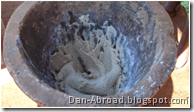
2. In a bowl of water, salt and sugar add the banana mash. Stir until you obtain an even consistency.
3. In a cup beat 2 eggs and pour into mixture, stirring continuously.
4. Add water as needed to obtain the consistency of thick oatmeal, again see picture.
5. Continuing to stir, add baking soda and oil.
6. Once mixture is even, pour into a greased baking pan and bake until golden brown and cooked through (middle rack at 400 deg F for 35 min).
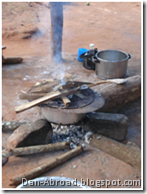
Slice into triangles and serve with tea, and as an extra treat spread peanut butter on top.
Rose
 Rose, one of my neighbours in Mpamba, the town in which I was placed is the biggest character I met in Malawi. Originally from Tanzania she is staying in the northern region of Malawi because as she sais, “I like this one” as she jesters to her husband, then laughs a very hearty, infections laugh. Rose’s husband is a maize farmer, as many people around Mpamba make their living and to supplement his income she bakes Mandasi, a delicious snack she sells in the market.
Rose, one of my neighbours in Mpamba, the town in which I was placed is the biggest character I met in Malawi. Originally from Tanzania she is staying in the northern region of Malawi because as she sais, “I like this one” as she jesters to her husband, then laughs a very hearty, infections laugh. Rose’s husband is a maize farmer, as many people around Mpamba make their living and to supplement his income she bakes Mandasi, a delicious snack she sells in the market. MANDASI
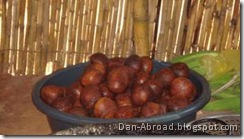 Mandasi is a really fun dish to make, as long as you are cautious with boiling oil. Even more fun is on a warm day in Malawi, venturing down to a village market hearing the women chat as they sell snack foods in the sun and spending your lose change on these unhealthy little bite-sized balls of joy. While I was cooking mandasi with Rose I persuaded her into trying to coat a couple in sugar before frying. She found them much to sweet, but if you’re craving a desert it’s a great choice to make. The recipe I’ve included here is for Mandasi with bananas, which is much less common than just plain fried dough balls, but I found much more delicious.
Mandasi is a really fun dish to make, as long as you are cautious with boiling oil. Even more fun is on a warm day in Malawi, venturing down to a village market hearing the women chat as they sell snack foods in the sun and spending your lose change on these unhealthy little bite-sized balls of joy. While I was cooking mandasi with Rose I persuaded her into trying to coat a couple in sugar before frying. She found them much to sweet, but if you’re craving a desert it’s a great choice to make. The recipe I’ve included here is for Mandasi with bananas, which is much less common than just plain fried dough balls, but I found much more delicious. Ingredients
PreparationWheat flour
Sugar
Bananas (or substitute pineapples, apples)
Baking powder
Yeast
Water
Vegetable oil
1. Slice bananas.
2. In a mixing bowl add water, flour, sugar, baking powder and yeast stirring progressively.
3. Set the mixing bowl aside to allow the dough to rise.
4.Sprinkle flour on a baking sheet, cutting board or other surface.
5. Once the dough has risen to be fluffy and somewhat elastic to the touch, sprinkle flour on your hands and grab a lump the desired size in your hands, ball the dough (or you can be more artful, I have seen doughnut-shaped and spiral shaped mandasi) pressing a slice of banana into the middle of the ball and set on the floured baking sheet. Continue balling until you have used up all the dough.
6. Set the baking sheet aside to allow the dough to rise again, the longer you let them rest, the fluffier your mandasi will be.
7. On low to medium heat in a pot or wok heat the oil, below a boil..
8. By touch, find the most fluffy dough balls, and carefully place them in the oil, not filling the pot but creating a layer which floats at the surface of the oil.
9. Fry until dark brown, being sure to evenly cook both sides.
10. Either serve hot, or carry on your head into the market and sell for ten kwacha each.
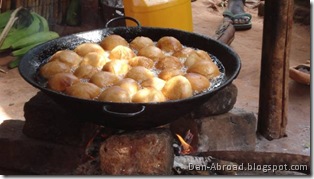
BAKED CASSAVA SNACK
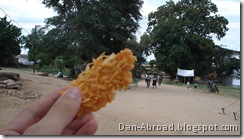 This is one of the crunchiest foods I’ve eaten in Malawi. It’s not a very common market food and I’ve only found it on a few occasions in the Nkhata Bay Boma (the capital city of the Nkhata Bay District of Malawi). I was unable to track down anyone who knew how to prepare the food, but I found the following recipe in The Malawi Cookbook, which has been a great reference in putting together this compilation of recipes.
This is one of the crunchiest foods I’ve eaten in Malawi. It’s not a very common market food and I’ve only found it on a few occasions in the Nkhata Bay Boma (the capital city of the Nkhata Bay District of Malawi). I was unable to track down anyone who knew how to prepare the food, but I found the following recipe in The Malawi Cookbook, which has been a great reference in putting together this compilation of recipes. Ingredients
Fresh CassavaPreparation
Oil or Fat
Pinch of Salt
1. Preheat oven on high heat.Staples:
2. Peel and grate cassava.
3. Spread on a baking tray and add a little oil and salt.
4. During baking occasionally spoon oil over cassava until they are well browned.
5. Break into pieces and serve.
NSIMA (see-mah, or en-see-mah depending on region)
Malawian food primarily revolves around the staple nsima, made with either maize or cassava flour. The ingredients for nsima are fairly simple, it’s the technique in preparing that adds a serious level of complexity. The mudiko is the tool for nsima preparation, essentially a flat wooden spatula it is used for stirring the mixture and smoothing out lumps. Maize nsima (nsima yavugoma) is soft and slightly sticky to the touch and served in separate lumps the size of a hand whereas cassava nsima (nsima yavugau) has a slightly rubbery consistency and is less sticky, leading to a much cleaner meal. It is however much thicker and torture on the arms to stir. Nsima is eaten with the hands (though forks and spoons are acceptable for a foreigner, though hardly practical) and used to scoop relishes into the mouth, like a pita.
Ingredients
2 to 3 cups WaterPreparation
1 cup Maize Flour
1. In a large pot heat water until lukewarm and add some flour and mix well.NSIMA YAVUGAU/CONDOLI (Cassava Nsima)
2. Bring the mixture to a boil and let boil for 2-4 minutes, stirring occasionally until it becomes a thin porridge.
3. From a bowl or large spoon periodically sprinkle in more flour, stirring continuously to avoid creating lumps.
4. Once the mixture reaches a consistency where there is considerable resistance to stirring with the mudiko begin stirring in a circular motion which scrapes nsima from the side of the pot then presses against the side facing you, thus smoothing out any lumps (see diagram).
5. Once the resistance to stirring and flattening lumps makes your arms sore (and I mean really sore) reduce heat and continue stirring (my host mother puts a flip flop between the pot and her foot and uses this leverage to smooth out every last lump).
6. Once you are satisfied and your arms feel like rubber, grab a likhezo (serving spoon) and dip it in cold water between serving lumps of nsima onto a plate. For maize nsima serve small palm to hand sized lumps.
7. Tear off a small lump in your palm, careful not to burn your fingers (eating is another lesson in technique) and scoop up or dip in your favourite relish (serves two).
A note of caution, cassava nsima burns much more easily and so while maize nsima is usually prepared before the relishes and kept on the heat cassava nsima should be prepared immediately prior to serving, though I don’t know how it fairs in the microwave.
Ingredients
2 to 3 cups Water
1 1/2 to 2 cups Cassava Flour
Preparation
1. Heat water with a layer of flour sprinkled on top to show when boiling has occurred.BAH ndi MPUNGA (porridge/gruel and rice)
2. Once the water starts boiling immediately add just over half of the flour to the water all at once and stir continuously until smooth (about 1 minute).
3. Remove from heat and add the remaining flour, stirring forcefully until the resistance is unbearable (about 5 minutes).
4. Scoop into small melon-sized lumps and serve hot (serves two).
Rice is another Malawian staple, and very common in the north around Karonga where rice patties flourish. Plain rice, without relish or seasoning (other than salt of course) can be served with tea for breakfast. At other meals, vegetable and meat relishes are stirred into the rice. All rice dishes are eaten with a knife and fork, despite the advice I received from a waitress with a sense of humour on my first day in Malawi.
Ingredients
SaltPreparation
Rice
Cooking Oil (Soybean oil)
1. In a pot of cool water briefly soak and rinse rice.Relishes:
2. Bring water, and liberal amounts of salt to a rolling boil.
3. Add rice to boiling water and cover (my family used plastic “Riders” bags and a plate, but I’m sure a pot lid works fine).
4. Maintain rolling boil until rice is soft to taste.
5. Strain off excess water. This can be served as a starchy porridge/pabulum to children called bah.
7. Remove pot from heat and add a small amount of cooking oil to rice and stir.
8. Cover pot again and place on coals/low heat.
9. Once there is no visible oil on rice (it have been absorbed into the grains) remove from heat and top with your favourite relish.
In Malawi, the term relish refers to any slightly saucy/stew-like dish that can be served with nsima, the staple food of most of Malawi and Zambia, poured over rice, or in Tanzania scooped up with a deep fried banana/plantain. Relishes can be beans, vegetables, nuts and every sort of meat. Essentially they’re what provide variety to a meal, the main dishes.
EGG RELISH
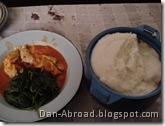
 This is my favourite relish that my family cooks at home. It’s a delicious main dish, served with vegetable relish on the side.
This is my favourite relish that my family cooks at home. It’s a delicious main dish, served with vegetable relish on the side.Ingredients
4 EggsPreparation
2 Tomatoes
Salt
Cooling oil (Soybean oil)
1. Add salt and eggs to a cut and beat.
2. Grease a pan with cooking oil and fry all 4 eggs in one layer like an omelette.
3. Dice tomatoes.
4. Remove eggs from heat and put into a plate or pot.
5. Re-grease frying pan and add diced tomatoes and salt to taste.
6. Sauté/stew tomatoes, placing the plate of eggs overtop as a cover and to keep the eggs warm.
7. When tomatoes are bubbling and have become soupy add eggs, stir and serve with nsima or over a bed of rice.
VEGETABLE RELISH
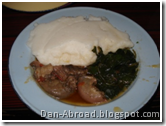 This vegetable relish makes a great side dish and can be seasoned a number of ways and stirred into rice, stuffed in a pita or of course scooped up with nsima.
This vegetable relish makes a great side dish and can be seasoned a number of ways and stirred into rice, stuffed in a pita or of course scooped up with nsima. Ingredients
Greens (Traditionally would be cassava leaves, rapini or potato leaves but baby spinach leaves and others would make an adequate substitute)Preparation
Tomatoes
Rock Salt
Soybean oil
1. Chop and steam greens, drain (but not thoroughly, leave some water on the leaves)Still hungry? You can view an album of all the food I’ve been eating at http://picasaweb.google.com/105874389983784481295/FoodStream?authkey=Gv1sRgCOq68cCcgbLcXg&feat=directlink
2. Dice and sauté tomatoes and onions separately in oil, adding salt
3. Once tomatoes are soft (almost at the point of stewing off the skin) add the greens into the pan stirring the whole mixture and adding salt to taste.
This comment has been removed by a blog administrator.
ReplyDelete